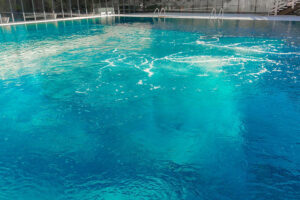Cloudy pool water can be a frustrating issue for any pool owner. If your pool looks uninviting, it may be a sign of issues with its chemistry or filtration system. Understanding the root causes of cloudy pool water is essential for effectively clearing it up and preventing future occurrences.
This guide will explain why problems with chemicals, filters, and contaminants can cause cloudiness. We will guide you through each step to help you clear up your pool, with useful tips for keeping the water in top condition.
If the thought of managing these issues seems overwhelming or you prefer spending your time enjoying your pool rather than fixing its problems, our team at Sea Breeze Pools is here to help. With our expertise and dedicated service, we’ll ensure your pool remains a pristine, inviting oasis all season long.
Click HERE for a FREE Service Quote from Sea Breeze Pools

Understanding Cloudy Pool Water
Chemical Imbalance:
Cloudy water in a pool is often caused by imbalanced chemical levels, like pH, chlorine, and alkalinity being off. When these levels are wrong, it can lead to the formation of particles that make the water appear cloudy.
For instance, low chlorine levels fail to sanitize the pool effectively, leading to bacterial and algae growth. High pH levels can cause calcium to precipitate out of the water, creating cloudiness. Read this blog which explains how to measure these elements.
Poor Filtration:
If your pool’s filter is not working properly, it cannot clean the water effectively. This can result in cloudy water caused by debris and particles. Problems like a dirty filter, not enough pump time, or a broken filtration system can cause this issue with your pool.
Environmental Factors:
Debris from trees, pollen, dust, and even heavy rain can introduce particles into your pool that cause the water to become cloudy. Algae blooms, often triggered by warm weather and poor chemical maintenance, can also turn your pool water green and cloudy.
Steps to Clear Cloudy Pool Water
Test and Balance Your Chemicals:
Start by testing your pool water using a reliable test kit or test strip. Check that your pH is within the range of 7.2 to 7.6. Ensure that your chlorine levels are between 1 and 3 ppm. Also, make sure your total alkalinity falls between 80 and 120 ppm.
Adjust these levels as needed using appropriate pool chemicals. For example, if the pH is too high, add a pH decreaser like sodium bisulfate. If the chlorine is low, shock your pool with a high dose of chlorine.
Shock Your Pool:
Shocking your pool involves adding a large dose of chlorine to eliminate contaminants that regular chlorination might miss. This process helps to kill bacteria, algae, and other organic matter that can cloud your water. Use pool shock according to instructions, and run the pump for 24 hours for best results.
Improve Filtration:
Check your pool’s filtration system to ensure it’s working correctly. Clean or backwash the filter to remove any debris that might be clogging it.
If your filter (sand, cartridge filter, or DE) is old or worn out, consider replacing it. Run your pool filter until the water clears. Increasing the pump run time can also enhance filtration, especially during peak usage times.
Use a Pool Clarifier:
Add the recommended amount of clarifier to your pool and let your filtration system do the rest. Clarifiers are particularly useful after heavy usage or storms that may introduce fine particles into the pool.
Vacuum and Brush:
Manual cleaning is crucial in the fight against cloudy water. Brush the walls and floor of your pool to loosen any particles, and then vacuum to remove them from the water. Use a pool vacuum or an automatic cleaner to ensure thorough cleaning. Don’t forget to clean out the skimmer and pump baskets regularly.
Preventing Future Cloudiness
Regular Testing:
Test your water at least once a week to catch any imbalances early. Pay attention to all key chemical levels, including pH, chlorine, alkalinity, and calcium hardness. Addressing minor imbalances promptly can prevent major issues down the line.
Consistent Cleaning:
Skim, brush, and vacuum your pool regularly to prevent debris buildup. Regularly cleaning the pool by removing leaves, insects, and debris is important. This helps keep the water clear and reduces strain on the filter.
Filter Maintenance: Clean or replace your filter as needed to ensure it’s working effectively. Make sure to follow the product’s instructions for maintenance. If you see a decrease in water flow, don’t be afraid to backwash or rinse the filter.
Proper Circulation:
Run your pump and filter for the recommended amount of time each day to keep the water moving and filtered. During hot weather or heavy usage, you might need to extend the pump run time to maintain optimal water quality.
Sea Breeze Pools: Experts in Keeping Your Pool Clear
Dealing with cloudy pool water can be a complex and time-consuming task, but you don’t have to handle it alone. Experience the improvement of professional pool care and enjoy a sparkling, clear pool without the hassle. We offer expert pool cleaning and maintenance services to ensure your pool stays crystal clear. Our team can diagnose and fix any issues, giving you more time to enjoy your pool.
Let us help you achieve and maintain perfect pool water clarity!
Contact Sea Breeze Pools today to learn more about our services and schedule a FREE consultation.






